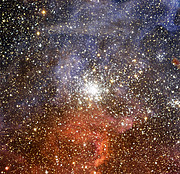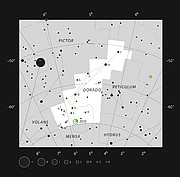Pressmeddelande
Unga stjärnor intar rampljuset
7 september 2011
Den uppseendeväckande vyn mot stjärnhopen NGC 2100 har fångats på bild av ESO:s teleskop NTT (“New Technology Telescope”). Den ljusstarka, så kallade öppna stjärnhopen är ungefär 15 miljoner år gammal och är belägen i det Stora magellanska molnet, en nära granne och satellitgalax till Vintergatan. Runt omkring hopen glöder gas som tillhör den närbelägna Tarantelnebulosan.
Astronomer förbiser ofta NGC 2100 på grund av dess grannar på himlen: den imponerande Tarantelnebulosan (eso0650) och superstjärnhopen RMC 136 (eso1030). Den glödande gasen i Tarantelnebulosan försöker till och med stjäla rampljuset även här – de starka färgerna i bilden visar nebulosans utkanter. Den här bilden skapades av flera exponeringar genom olika filter med kameran EMMI [1] på teleskopet NTT vid ESO:s La Silla-observatorium i Chile. Stjärnorna visas i sina verkliga färger tillsammans med ljuset från glödande, joniserad vätgas och syrgas i rött respektive blått.
Vilka färger som syns i nebulosan beror på temperaturen hos de stjärnor som lyser upp den. De heta och unga stjärnorna i Tarantelnebulosan, inuti superstjärnhopen RMC 136, finns ovanför till höger utanför bilden. De är tillräckligt energirika för att kunna få syre att glöda [2] vilket syns som de blåa områden i bilden. Det röda skenet man kan se nedanför NGC 2100 i bilden kan bero på att detta område är i utkanten av de heta stjärnornas påverkan. Alternativt är det kallare och äldre stjärnor, som bara ger ifrån sig tillräckligt med energi för att få vätgas att glöda, som dominerar området. Stjärnorna som utgör NGC 2100 är äldre och avger ännu mindre energi, och därför kan det inte vara de som får gasen att glöda.
En stjärnhop består av stjärnor som föddes ungefär samtidigt ur samma moln av gas och stoft. De tyngsta stjärnorna bildas helst i hopens mitt, medan de med mindre massa dominerar de yttre områdena. Tillsammans med stjärnornas högre täthet i centrum gör detta att mitten av hopen lyser starkare än dess utkanter.
NGC 2100 är en öppen stjärnhop. Detta betyder att dess stjärnor är relativt löst bundna till varandra av tyngdkraften. Hopar som denna har en livslängd på ett tiotal till hundratals miljoner år. Därefter skingras de på grund av tyngdkraftspåverkan från andra objekt. Klotformiga stjärnhopar, som ser likadana ut för det otränade ögat, innehåller mänga fler äldre stjärnor och är mycket tätare ihopbundna. De har därför mycket längre livslängd, och många klotformiga hopar har uppmätts att vara nästan lika gamla som universum självt. Så även om NGC 2100 är äldre än sina grannar i det Stora magellanska molnet, så är den fortfarande ung för att vara en stjärnhop.
Data som användes för att skapa bilden av denna underskattade unga stjärnhop valdes ut från ESO:s väldiga dataarkiv av “Hidden Treasures”-deltagaren David Roma under hans medverkan i astrofototävlingen som anordnades av ESO år 2010 [3].
Noter
[1] EMMI är en förkortning av “ESO Multi Mode Instrument”. Instrumentet är både en kamera och en spektrograf.
[2] Större delen av glöden från syret kommer från syreatomer som har förlorat två elektroner. Den starka utstrålning från dessa partiklar är mycket vanlig i nebulosor, men för astronomer som tidigt använde sig av spektra var den svårtolkad. Man trodde från början att strålningen kom från ett nytt ämne, som gavs namnet Nebulium.
[3] Tävlingen “ESO’s Hidden Treasures 2010” gav amatörastronomer chansen att leta fram en väl gömd pärla som väntade på att poleras i ESO:s väldiga arkiv av astronomidata. För att få veta mer om “Hidden Treasures”, besök http://www.eso.org/public/events/hiddentreasures/.
Mer information
Länkar
Kontakter
Robert Cumming
Onsala rymdobservatorium, kontaktperson för ESO:s utåtriktade verksamhet i Sverige
Göteborg, Sverige
Tel: +46 31 7725500
Mobil: +46 704933114
E-post: robert.cumming@chalmers.se
Richard Hook
ESO, La Silla, Paranal, E-ELT and Survey Telescopes Public Information Officer
Garching bei München, Germany
Tel: +49 89 3200 6655
Mobil: +49 151 1537 3591
E-post: rhook@eso.org
Om pressmeddelandet
| Pressmeddelande nr: | eso1133sv |
| Namn: | Large Magellanic Cloud, LMC, NGC 2100 |
| Typ: | Local Universe : Star : Grouping : Cluster : Open |
| Facility: | New Technology Telescope |
| Instruments: | EMMI |




